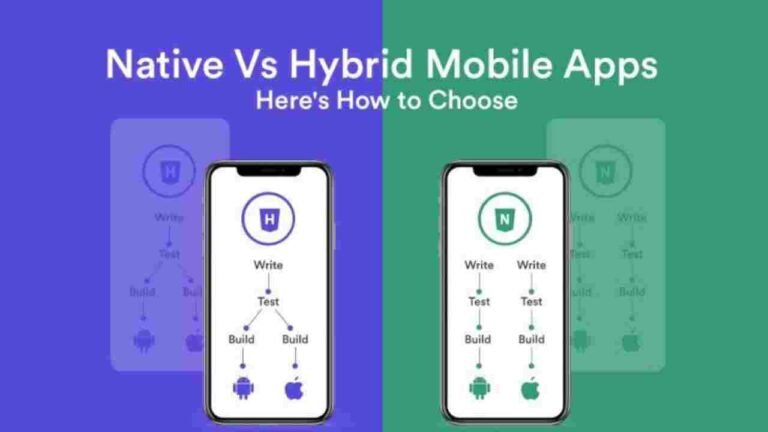In the world of mobile app development, one of the most critical decisions you’ll need to make is whether to build a native app or a hybrid app. Both types have their advantages, but choosing the right approach depends on several factors such as your app’s functionality, target audience, timeline, and budget.
In this article, we will explore the key differences between native apps and hybrid apps, discussing their benefits, drawbacks, and which one is most suitable for your mobile project.
1. What Are Native Apps?
A native app is a mobile application developed specifically for one platform (either iOS or Android). These apps are built using platform-specific programming languages—Swift or Objective-C for iOS, and Java or Kotlin for Android. Native apps are installed directly onto the device and are optimized for performance, speed, and user experience.
1.1. Characteristics of Native Apps
- Platform-Specific Development: Native apps are built for a specific operating system (iOS or Android) using the languages and tools provided by the platform (e.g., Xcode for iOS, Android Studio for Android).
- App Store Distribution: Native apps are distributed through app stores like Apple’s App Store or Google Play.
- Access to Device Features: Native apps have full access to all the features of the device, such as the camera, GPS, contacts, and other hardware features.
1.2. Advantages of Native Apps
- Performance: Since native apps are built specifically for one platform, they tend to perform better and run faster than hybrid apps.
- User Experience: Native apps offer a smoother and more responsive experience because they are optimized for the platform’s design guidelines and capabilities.
- Access to Device Features: Native apps can fully utilize all device-specific features (camera, accelerometer, microphone, etc.) for a more integrated experience.
- Better Offline Capabilities: Native apps can function more effectively offline, as they store data locally on the device.
1.3. Disadvantages of Native Apps
- Higher Development Cost: Native apps require separate development for each platform, meaning higher initial development costs.
- Longer Time to Market: Building two separate apps for iOS and Android can take longer, which delays the launch.
- Maintenance: Native apps need to be updated separately for each platform, which can be time-consuming and costly.
2. What Are Hybrid Apps?
A hybrid app is a mobile application that combines elements of both native apps and web apps. Hybrid apps are built using web technologies like HTML5, CSS, and JavaScript, and then wrapped inside a native container that allows them to run on multiple platforms. This approach enables the app to be deployed across both iOS and Android with a single codebase.
2.1. Characteristics of Hybrid Apps
- Cross-Platform Development: Hybrid apps are developed using web technologies (HTML5, CSS, JavaScript) and then compiled into native apps using frameworks such as React Native, Ionic, or Flutter.
- App Store Distribution: Like native apps, hybrid apps are distributed through app stores (Apple App Store, Google Play).
- Web-Based Functionality: Hybrid apps rely on a webview for some functionality and content, which means they can interact with the web while still offering some native-like capabilities.
2.2. Advantages of Hybrid Apps
- Single Codebase: Hybrid apps are built using a single codebase, making them faster and cheaper to develop, especially if you’re targeting both iOS and Android users.
- Faster Time to Market: Since hybrid apps use one codebase, they can be developed and launched faster than native apps.
- Cost-Effective: Developing and maintaining a hybrid app is usually more affordable than building two separate native apps for iOS and Android.
- Easier Maintenance: Updating and maintaining a hybrid app is simpler, as changes only need to be made to the single codebase.
2.3. Disadvantages of Hybrid Apps
- Performance Issues: Hybrid apps may not perform as smoothly as native apps, especially when handling complex tasks like animations or high-end graphics.
- Limited Access to Device Features: While hybrid apps can access some device features, they may not have the same level of access or performance as native apps when it comes to advanced functionalities.
- User Experience: Hybrid apps might not provide the same fluid user experience as native apps because they are limited by the performance of the webview and the framework used.
3. Key Differences Between Native and Hybrid Apps
Understanding the key differences between native and hybrid apps is essential when choosing the right approach for your project. Below, we compare the two on several important factors:
3.1. Development Cost
- Native Apps: More expensive, as they require separate development for iOS and Android.
- Hybrid Apps: More cost-effective, as a single codebase can be used for both platforms.
3.2. Performance
- Native Apps: Superior performance, faster load times, and better handling of complex tasks and graphics.
- Hybrid Apps: May have slower performance, especially for graphics-intensive applications or complex animations.
3.3. User Experience (UX)
- Native Apps: Excellent user experience, as they are optimized for each platform and follow platform-specific design guidelines.
- Hybrid Apps: User experience can be slightly less fluid, as they are reliant on web technologies and may not fully adhere to native design principles.
3.4. Development Time
- Native Apps: Longer development time due to the need to create separate codebases for each platform.
- Hybrid Apps: Faster development time, as the same codebase can be used for both iOS and Android.
3.5. Maintenance
- Native Apps: Maintenance is more complex and costly, as updates need to be made separately for iOS and Android.
- Hybrid Apps: Easier and cheaper to maintain, as updates can be made on the single codebase.
4. When to Choose Native Apps
Native apps are ideal for certain projects where performance and user experience are top priorities. You should consider building a native app if:
- Your app requires high performance, such as gaming apps or apps with complex animations.
- You need deep integration with the device’s hardware, such as GPS, camera, or accelerometer.
- You are targeting users in a specific ecosystem (iOS or Android) and are not concerned about supporting both platforms.
- Your app needs to provide offline functionality, where data can be stored locally and accessed without an internet connection.
5. When to Choose Hybrid Apps
Hybrid apps are a great choice for projects with a tighter budget and timeline. You should consider building a hybrid app if:
- You want to target both iOS and Android platforms without duplicating effort.
- You need to launch quickly, especially for MVPs (Minimum Viable Products) or prototypes.
- You’re working with a limited budget and need to build a functional app that provides core features without the need for high-end performance.
- Your app is content-heavy, such as blogs, news apps, or social media apps, where performance and complex functionality are not critical.
6. Conclusion
Choosing between native and hybrid app development depends on your project’s goals, budget, and timeline. Native apps offer superior performance, user experience, and access to device features, making them ideal for apps that require high performance or deep integration. On the other hand, hybrid apps are cost-effective and allow you to reach both iOS and Android users with a single codebase, making them a great choice for simpler apps or projects with limited resources.
Evaluate your project needs, weigh the pros and cons, and choose the approach that best aligns with your app’s objectives and your resources. By understanding the differences between native and hybrid apps, you can make a more informed decision and create a successful mobile app that meets both user expectations and business goals.

